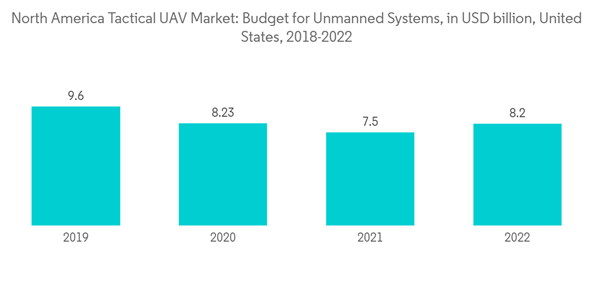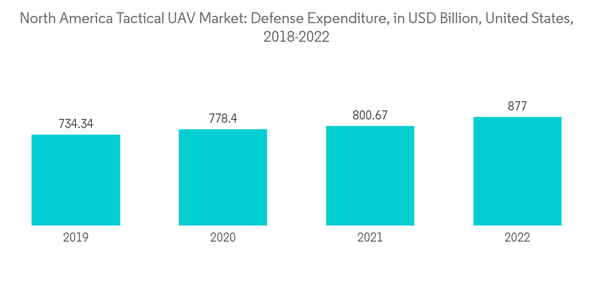Unmanned aerial vehicles (UAVs) are primarily used by the military and law enforcement for combat, long-range surveillance, and reconnaissance missions due to operational and strategic advantages brought by beyond visual line of sight (BVLOS), where the benefits related to cost, reliability, and operational risk mitigation are matched by the increased ability to project power that the platform allows, either through deniability or by making BVLOS available to proxies and allies.
An increase in focus on enhancing intelligence, surveillance, and reconnaissance (ISR) capabilities and growing defense spending are the major factors driving the market growth. The ability of UAVs to track down and disable an enemy without coming into its site is a major advantage that is helping the growth of the market.
The use of UAVs for national security and counter-terrorism will also be a major factor in the growth of the market in the North American region. Integrating technologies, like artificial intelligence (AI), into the existing tactical UAV technologies may provide opportunities for the development of advanced tactical UAV systems in the years to come.
North America Tactical UAV Market Trends
Military Segment To Dominate Market Share During the Forecast Period
The military segment dominated the market during the forecast period. Technological advancement is one of the key factors fueling the demand for tactical UAVs in the current battlefield scenarios. Tactical UAVs are traditionally used for surveillance and reconnaissance purposes. With the incorporation of advanced technologies and advancements in sensor technologies, tactical UAVs have evolved to facilitate various combat demands and missions. Tactical UAVs are now being used for electronic warfare, along with wide-area surveillance.In addition to data transfer to both manned aircraft and ground stations, they are also being used for combat support. For instance, Northrop Grumman RQ-4 Global Hawk is equipped with AESA radar that has sensing and jamming capabilities. The ease of countering a target from a faraway distance with high accuracy and zero risks to the operator is making tactical UAVs a preferred choice on the battlefield.
For instance, in July 2022, Lockheed Martin eyed a mix of expendable drone wingmen and more advanced autonomous systems for the US Air Force to team up with its manned fighters. With the development of technology, the procurement and operating costs of these UAVs are also coming down, thus propelling the adoption by militaries.
United States Will Showcase Significant Growth During the Forecast Period
The US is currently the largest market for tactical UAVs in North America. With the presence of major manufacturers, such as Boeing, Northrop Grumman, and Lockheed Martin, and the biggest defense budget in the world, the US is currently the largest user of tactical UAVs.The US has been one of the pioneers in using tactical UAVs for military purposes. The country has a large fleet of such UAVs. With high defense spending and the growing R&D in these technologies, many new and advanced tactical UAVs are being inducted into the militaries and law enforcement agencies in the countries.
The US Department of Defense (DoD) increased its spending on electromagnetic spectrum operations and electronic warfare in the last five years. In 2023, the US showed security concerns over some UAVs made in China or with Chinese components, especially after shooting down a spy balloon, which the Pentagon believes to be a Chinese one. This may propel the local manufacturing of tactical UAVs in the country. According to the US defense budget overview, the DoD invested USD 2.6 billion has been allocated for UAVs for FY2024.
The US is a proven global leader in producing advanced unmanned systems and a specialist in manufacturing UAVs with intelligence, surveillance, and reconnaissance (ISR) capabilities to combat warfare. The requirement of a constant and superior ISR capability for its armed forces has stimulated the US to invest substantially in unmanned air systems and related technologies. The HALE and UCAV programs are expected to dominate the procurement expenditure during the forecast period, as the US military expects to induct more tactical UAVs with enhanced endurance and additional weapon-bearing capabilities in the coming years. For instance, in October 2022, the US Air Force experimented with Boeing’s MQ-28 Ghost Bat drone to validate technologies crucial to advancing and fielding next-generation capabilities. Along with developing new UAVs, the US is also investing in modifying the existing UAVs, and in the FY2024 budget, USD 547.8 million was allocated for the modification of 5 US Air Force MQ-9 Reapers. The programs above and developments will enhance the prospects for tactical UAVs in the country during the forecast period.
North America Tactical UAV Industry Overview
The North American tactical UAV market is semi-consolidated in nature, with few players holding significant shares in the market. Northrop Grumman Corporation, Elbit Systems Ltd., IAI, Lockheed Martin Corporation, and AeroVironment Inc. are some of the major players in the market.Manufacturers are constantly striving to improve UAV sensors, including visual cameras, infrared detectors, multispectral and hyperspectral sensors, light detection and ranging (LiDAR), inertial measurement units, gyros, and other sensors that provide more precise information for ISR applications. The focus on producing sensors that are smaller, lighter, faster, cheaper, more reliable, more accurate, and more sensitive is expected to drive innovations in the market during the forecast period.
Joint development of advanced tactical UAVs will likely facilitate the technology transfer, thereby helping the growth of the players in the years to come. For instance, in July 2022, ARA Robotics partnered with OneSky to deliver a remotely piloted aerial system (RPAS) test range solution for operations carried out at the Qualia Qualification Site. Qualia is one of the first Canadian training, development, and prequalification test sites for RPAS, and it is part of Quebec’s Center for Excellence in Drones (CED) at ALMA.
Additional Benefits:
- The market estimate (ME) sheet in Excel format
- 3 months of analyst support
This product will be delivered within 2 business days.
Table of Contents
Companies Mentioned (Partial List)
A selection of companies mentioned in this report includes, but is not limited to:
- Northrop Grumman Corporation
- General Atomics
- AeroVironment Inc.
- Lockheed Martin Corporation
- Airbus SE
- Elbit Systems Ltd
- Safran
- The Boeing Company
- Israel Aerospace Industries
- Textron Inc.










